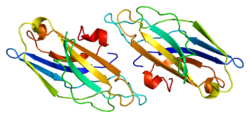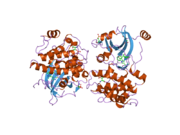PRKCB1
Appearance
Protein kinase C beta type is an enzyme that in humans is encoded by the PRKCB gene.[5]
Interactions
PRKCB1 has been shown to interact with RIPK4,[7] beta adrenergic receptor kinase,[8] PDLIM5[9] and GNB2L1.[10]
See also
References
- ^ a b c GRCh38: Ensembl release 89: ENSG00000166501 – Ensembl, May 2017
- ^ a b c GRCm38: Ensembl release 89: ENSMUSG00000052889 – Ensembl, May 2017
- ^ "Human PubMed Reference:". National Center for Biotechnology Information, U.S. National Library of Medicine.
- ^ "Mouse PubMed Reference:". National Center for Biotechnology Information, U.S. National Library of Medicine.
- ^ Kubo K, Ohno S, Suzuki K (November 1987). "Nucleotide sequence of the 3' portion of a human gene for protein kinase C beta I/beta II". Nucleic Acids Res. 15 (17): 7179–80. doi:10.1093/nar/15.17.7179. PMC 306204. PMID 3658678.
- ^ Lintas C; Sacco R; Garbett K; Mirnics K; Militerni R; Bravaccio C; Curatolo P; Manzi B; Schneider C; Melmed R; Elia M; Pascucci T; S Puglisi-Allegra; K-L Reichelt; Persico AM (2009). "Involvement of the PRKCB1 gene in autistic disorder: significant genetic association and reduced neocortical gene expression". Mol Psychiatry. 14 (7): 705–718. doi:10.1038/mp.2008.21. PMID 18317465.
- ^ Chen, L; Haider K; Ponda M; Cariappa A; Rowitch D; Pillai S (June 2001). "Protein kinase C-associated kinase (PKK), a novel membrane-associated, ankyrin repeat-containing protein kinase". J. Biol. Chem. 276 (24): 21737–44. doi:10.1074/jbc.M008069200. PMID 11278382.
{{cite journal}}: CS1 maint: unflagged free DOI (link) - ^ Yang, Xing-Long; Zhang Ya-Li; Lai Zhuo-Sheng; Xing Fei-Yue; Liu Yu-Hu (April 2003). "Pleckstrin homology domain of G protein-coupled receptor kinase-2 binds to PKC and affects the activity of PKC kinase". World J. Gastroenterol. 9 (4): 800–3. PMID 12679936.
- ^ Kuroda, S; Tokunaga C; Kiyohara Y; Higuchi O; Konishi H; Mizuno K; Gill G N; Kikkawa U (December 1996). "Protein-protein interaction of zinc finger LIM domains with protein kinase C". J. Biol. Chem. 271 (49): 31029–32. doi:10.1074/jbc.271.49.31029. PMID 8940095.
{{cite journal}}: CS1 maint: unflagged free DOI (link) - ^ Ron, D; Jiang Z; Yao L; Vagts A; Diamond I; Gordon A (September 1999). "Coordinated movement of RACK1 with activated betaIIPKC". J. Biol. Chem. 274 (38): 27039–46. doi:10.1074/jbc.274.38.27039. PMID 10480917.
{{cite journal}}: CS1 maint: unflagged free DOI (link)
Further reading







